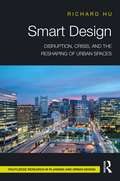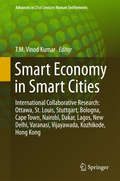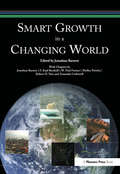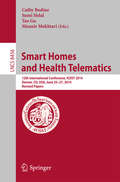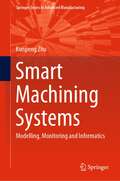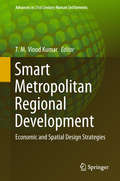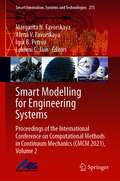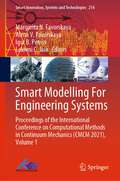- Table View
- List View
Smart Design: First International Conference Proceedings
by Philip BreedonGood product designs merge materials, technology and hardware into a unified user experience; one where the technology recedes into the background and people benefit from the capabilities and experiences available. By focusing on functional gain, critical awareness and emotive connection, even the most multifaceted and complex technology can be made to feel straightforward and become an integral part of daily life. Researchers, designers and developers must understand how to progress or appropriate the right technical and human knowledge to inform their innovations. The 1st International Smart Design conference provides a timely forum and brings together researchers and practitioners to discuss issues, identify challenges and future directions, and share their R&D findings and experiences in the areas of design, materials and technology.This proceedings of the 1st Smart Design conference held at Nottingham Trent University in November 2011 includes summaries of the talks given on topics ranging from intelligent textiles design to pharmaceutical packaging to the impact of social and emotional factors on design choices with the aim of informing and inspiring future application and development of smart design.
Smart Design: Disruption, Crisis, and the Reshaping of Urban Spaces
by Richard HuThis book tackles the emerging smart urbanism to advance a new way of urban thinking and to explore a new design approach. It unravels several urban transformations in dualities: economic relationality and centrality, technological flattening and polarisation, and spatial division and fusion. These dualities are interdependent; concurrent, coexisting, and contradictory, they are jointly disrupting and reshaping many aspects of contemporary cities and spaces. The book draws on a suite of international studies, experiences, and observations, including case studies in Beijing, Singapore, and Boston, to reveal how these processes are impacting urban design, development, and policy approaches. The COVID-19 pandemic has accelerated many changes already in motion, and provides an extreme circumstance for reflecting on and imagining urban spaces. These analyses, thoughts, and visions inform an urban imaginary of smart design that incorporates change, flexibility, collaboration, and experimentation, which together forge a paradigm of urban thinking. This paradigm builds upon the modernist and postmodernist urban design traditions and extends them in new directions, responding to and anticipating a changing urban environment. The book proposes a smart design manifesto to stimulate thought, trigger debate, and, hopefully, influence a new generation of urban thinkers and smart designers. It will be of interest to scholars, students, and practitioners in the fields of urban design, planning, architecture, urban development, and urban studies.
Smart Design: Disruption, Crisis, and the Reshaping of Urban Spaces
by Richard HuThis book tackles the emerging smart urbanism to advance a new way of urban thinking and to explore a new design approach. It unravels several urban transformations in dualities: economic relationality and centrality, technological flattening and polarisation, and spatial division and fusion. These dualities are interdependent; concurrent, coexisting, and contradictory, they are jointly disrupting and reshaping many aspects of contemporary cities and spaces. The book draws on a suite of international studies, experiences, and observations, including case studies in Beijing, Singapore, and Boston, to reveal how these processes are impacting urban design, development, and policy approaches. The COVID-19 pandemic has accelerated many changes already in motion, and provides an extreme circumstance for reflecting on and imagining urban spaces. These analyses, thoughts, and visions inform an urban imaginary of smart design that incorporates change, flexibility, collaboration, and experimentation, which together forge a paradigm of urban thinking. This paradigm builds upon the modernist and postmodernist urban design traditions and extends them in new directions, responding to and anticipating a changing urban environment. The book proposes a smart design manifesto to stimulate thought, trigger debate, and, hopefully, influence a new generation of urban thinkers and smart designers. It will be of interest to scholars, students, and practitioners in the fields of urban design, planning, architecture, urban development, and urban studies.
Smart Economy in Smart Cities: International Collaborative Research: Ottawa, St.Louis, Stuttgart, Bologna, Cape Town, Nairobi, Dakar, Lagos, New Delhi, Varanasi, Vijayawada, Kozhikode, Hong Kong (Advances in 21st Century Human Settlements)
by T. M. Vinod KumarThe present book highlights studies that show how smart cities promote urban economic development. The book surveys the state of the art of Smart City Economic Development through a literature survey. The book uses 13 in depth city research case studies in 10 countries such as the North America, Europe, Africa and Asia to explain how a smart economy changes the urban spatial system and vice versa. This book focuses on exploratory city studies in different countries, which investigate how urban spatial systems adapt to the specific needs of smart urban economy. The theory of smart city economic development is not yet entirely understood and applied in metropolitan regional plans. Smart urban economies are largely the result of the influence of ICT applications on all aspects of urban economy, which in turn changes the land-use system. It points out that the dynamics of smart city GDP creation takes ‘different paths,’ which need further empirical study, hypothesis testing and mathematical modelling. Although there are hypotheses on how smart cities generate wealth and social benefits for nations, there are no significant empirical studies available on how they generate urban economic development through urban spatial adaptation. This book with 13 cities research studies is one attempt to fill in the gap in knowledge base.
Smart Graphics: 10th International Symposium on Smart Graphics, Banff, Canada, June 24-26 Proceedings (Lecture Notes in Computer Science #6133)
by Pierre Boulanger Antonio Krüger Patrick Olivier Robyn TaylorSmart Graphics: 10th International Symposium, SG 2009, Salamanca, Spain, Mai 28-30, 2009, Proceedings (Lecture Notes in Computer Science #5531)
by Andreas Butz Brian Fisher Marc Christie Antonio Krüger Patrick Olivier Roberto TherónThis book constitutes the refereed proceedings of the 10th International Symposium on Smart Graphics, SG 2009, held in Salamanca, Spain in May 2009. The 15 revised full papers together with 8 short papers and 2 demonstrations presented were carefully reviewed and selected. The papers are organized in topical sections on visual analytics, user studies, human computer interaction, computer graphics and artificial intelligence, as well as virtual and mixed reality.
Smart Graphics: 5th International Symposium, SG 2005, Frauenwörth Cloister, Germany, August 22-24, 2005, Proceedings (Lecture Notes in Computer Science #3638)
by Andreas Butz Brian Fisher Antonio Krüger Patrick OlivierSmart Graphics: 6th International Symposium, SG 2006, Vancover, Canada, July 23-25, 2006, Proceedings (Lecture Notes in Computer Science #4073)
by Andreas Butz Brian Fisher Antonio Krüger Patrick OlivierThis book constitutes the refereed proceedings of the 6th International Symposium on Smart Graphics, SG 2006, held in Vancouver, Canada, July 2006. The book presents 19 revised full papers and 8 revised short papers. The papers are organized in topical sections on intelligent text processing, perceptive systems, smart visualization, visual features, sketching and graphical abstraction, intelligent image and film composing, as well as smart interaction.
Smart Graphics: 9th International Symposium, SG 2008, Rennes, France, August 27-29, 2008, Proceedings (Lecture Notes in Computer Science #5166)
by Andreas Butz Brian Fisher Antonio Krüger Patrick Olivier Marc ChristieFor centuries, artists and designers have been creating communicative graphics. With the advent of new forms of media, the emergence of paradigms such as ubiquitous computing, and the rapid evolution of interaction devices, there is a continuous cycle of renewal of the technologies and methods to support artists, interaction designers and developers. Developingnewapproachesrequiresanunderstandingofthe fundamentals of perception and cognition as they relate to interaction and communication te- nologies, together with arti?cial intelligence and computer graphics techniques to automate reasoning and enhance cognition. Smart Graphics is in essence an interdisciplinary endeavor and brings together the ?elds of computer graphics, arti?cial intelligence, cognitive science, graphic design and ?ne art. The International Symposium on Smart Graphics 2008 was held on August 27–29 in Rennes, France. It was the ninth event in a series which originally started in 2000 as an American Association for Arti?cial Intelligence Spring Symposium and has taken place every year since then. Due to the high quality of the papers submitted this year, the ProgramCommittee decided to accept 17 fullpapers(insteadoftheusual15),9shortpapersand3systemdemonstrations. The acceptance rate for full papers was 34%. This year’s meeting included a discussion as to the nature of the shape, contentandfutureoftheevent.Representativesfromdi?erentcommunitieswere invitedtogivetheiropinions,andtheorganizingcommitteewouldliketowarmly thank them here. Such questions as the ongoing viability of the symposium and theconsequencesofco-locatingSmartGraphicswithotherlargerresearchevents led to interesting debates and have prepared the groundwork for what could be the future of the Smart Graphics conference series.
Smart Graphics: 8th International Symposium, SG 2007, Kyoto, Japan, June 25-27, 2007, Proceedings (Lecture Notes in Computer Science #4569)
by Andreas Butz Brian Fisher Antonio Krüger Patrick Olivier Shigeru OwadaThis book constitutes the refereed proceedings of the 8th International Symposium on Smart Graphics, SG 2007, held in Kyoto, Japan in June 2007 jointly with the Visual Computing / Graphics and CAD symposium, which takes place in Osaka, Japan. It covers interaction, lifelike characters and affective computing, knowledge-based graphics generation and interaction, and visualization and graphics algorithms.
Smart Graphics: 4th International Symposium, SG 2004, Banff, Canada, May 23-25, 2004, Proceedings (Lecture Notes in Computer Science #3031)
by Andreas Butz Antonio Krüger Patrick OlivierSmart Graphics: 12th International Symposium, SG 2014, Taipei, Taiwan, August 27-29, 2014, Proceedings (Lecture Notes in Computer Science #8698)
by Marc Christie Tsai-Yen LiThis book constitutes the proceedings of the 12th International Symposium on Smart Graphics, SG 2014, held in Taipei, Taiwan, in August 2014. The 14 full and 4 short papers presented in this volume were carefully reviewed and selected from 26 submissions. They are organized in topical sections named: data visualization; sketching and multi-touch interaction; aesthetics and smart tools for artists; smart tools for 3D contents; and posters.
Smart Graphics: 11th International Symposium on Smart Graphics, Bremen, Germany, July 18-20, 2011. Proceedings (Lecture Notes in Computer Science #6815)
by Lutz Dickmann Gerald Volkmann Rainer Malaka Susanne Boll Antonio Krüger Patrick OlivierThis book constitutes the refereed proceedings of the 11th International Symposium on Smart Graphics, SG 2011, held in Bremen, Germany, in July 2011. The 10 revised full papers presented together with 12 short papers and 4 systems demonstrations were carefully reviewed and selected from numerous submissions covering a wide range of topics including view and camera control; three-dimensional modeling; visual information encoding; video projection; information visualization; interaction techniques; visual communication; and graphics and audio.
Smart Graphics: 13th International Symposium, SG 2015, Chengdu, China, August 26-28, 2015, Revised Selected Papers (Lecture Notes in Computer Science #9317)
by Yaxi Chen, Marc Christie and Wenrong TanThis book constitutes the proceedings of the 13th International Symposium on Smart Graphics, SG 2015, held in Chengdu, China, in August 2015. The 17 full and 3 short papers presented in this volume were carefully reviewed and selected from 35 submissions. They are organized in topical sections named: graphics, sketching and visualization, automation and evaluation, image processing, and posters and demo session.
Smart Grapics: Third International Symposium, SG 2003, Heidelberg, Germany, July2-4, 2003, Proceedings (Lecture Notes in Computer Science #2733)
by Andreas Butz Antonio Krüger Patrick OlivierThe International Symposium on Smart Graphics 2003 was held on July 2–4, 2003 in Heidelberg, Germany. It was the fourth event in a series that started in 1999 as an AAAI Spring Symposium. In response to the overwhelming success of the 1999 symposium, its organizers decided to turn it into a self-contained event in2000. WiththesupportofIBM,the?rsttwoInternationalSymposiaonSmart Graphics were held at the T. J. Watson Research Center in Hawthorne, NY. The 2003 symposium was supported by the Klaus Tschira Foundation and moved to the European Media Lab in Heidelberg, thus underlining the international character of the Smart Graphics enterprise and its community. The core idea behind these symposia is to bring together researchers and practitioners from the ?eld of computer graphics, arti?cial intelligence, cog- tive psychology, and ?ne art. Each of these disciplines contributes to what we mean by the term “Smart Graphics”: the intelligent process of creating expr- sive and esthetic graphical presentations. While artists and designers have been creating communicative graphics for centuries, arti?cial intelligence focuses on automating this process by means of the computer. While computer graphics provides the tools for creating graphical presentations in the ?rst place, cog- tive sciences contribute the rules and models of perception necessary for the design of e?ective graphics. The exchange of ideas between these four discip- nes has led to many exciting and fruitful discussions, and the Smart Graphics Symposia draw their liveliness from a spirit of open minds and the willingness to learn from and share with other disciplines.
Smart Growth in a Changing World
by Jonathan BarnettThis book is the latest book from the author, documents the United States' hidden crisis and shows how balanced transportation and natural resources preservation can make new urban development sustainable, as well as more efficient and more equitable.
Smart Growth in a Changing World
by Jonathan BarnettThis book is the latest book from the author, documents the United States' hidden crisis and shows how balanced transportation and natural resources preservation can make new urban development sustainable, as well as more efficient and more equitable.
Smart Homes and Health Telematics: 12th International Conference, ICOST 2014, Denver, CO, USA, June 25-27, 2014, Revised Papers (Lecture Notes in Computer Science #8456)
by Cathy Bodine Sumi Helal Tao Gu Mounir MokhtariThis book constitutes the thoroughly refereed post-conference proceedings of the 12th International Conference on Smart Homes and Health Telematics, ICOST 2014, held in Denver, CO, USA in June 2014.The 21 revised full papers presented together with three keynote papers and 9 short papers were carefully reviewed and selected from numerous submissions. The papers are organized in topical sections on Design and Usability, assistive and sentient environments, cognitive technology, activity recognition, context and situation awareness, Health IT and short contributions.
Smart Machining Systems: Modelling, Monitoring and Informatics (Springer Series in Advanced Manufacturing)
by Kunpeng ZhuThis book provides the tools to enhance the precision, automation and intelligence of modern CNC machining systems. Based on a detailed description of the technical foundations of the machining monitoring system, it develops the general idea of design and implementation of smart machining monitoring systems, focusing on the tool condition monitoring system. The book is structured in two parts. Part I discusses the fundamentals of machining systems, including modeling of machining processes, mathematical basics of condition monitoring and the framework of TCM from a machine learning perspective. Part II is then focused on the applications of these theories. It explains sensory signal processing and feature extraction, as well as the cyber-physical system of the smart machining system. Its utilisation of numerous illustrations and diagrams explain the ideas presented in a clear way, making this book a valuable reference for researchers, graduate students and engineers alike.
Smart Materials and Technologies in Architecture
by Michelle Addington Daniel SchodekToday, architects and designers are beginning to look toward developments in new"smart" or "intelligent" materials and technologies for solutions to long-standing problemsin building design. However, these new materials have so far been applied in a diversebut largely idiosyncratic nature, because relatively few architects have access toinformation about the types or properties of these new materials or technologies.Two of the leading experts in this field - Addington and Schodek - have solved thisproblem by incorporating all the relevant information of all the latest technologiesavailable to architects and designers in this one volume. They present materials bydescribing their fundamental characteristics, and go on to identify and suggest howthese same characteristics can be exploited by professionals to achieve their designgoals. Here, the wealth of technical understanding already available in the materialsscience and engineering literature is at last made accessible to a design audience.
Smart Materials and Technologies in Architecture: For The Architecture And Design Professions
by Michelle Addington Daniel SchodekToday, architects and designers are beginning to look toward developments in new"smart" or "intelligent" materials and technologies for solutions to long-standing problemsin building design. However, these new materials have so far been applied in a diversebut largely idiosyncratic nature, because relatively few architects have access toinformation about the types or properties of these new materials or technologies.Two of the leading experts in this field - Addington and Schodek - have solved thisproblem by incorporating all the relevant information of all the latest technologiesavailable to architects and designers in this one volume. They present materials bydescribing their fundamental characteristics, and go on to identify and suggest howthese same characteristics can be exploited by professionals to achieve their designgoals. Here, the wealth of technical understanding already available in the materialsscience and engineering literature is at last made accessible to a design audience.
Smart Metropolitan Regional Development: Economic and Spatial Design Strategies (Advances in 21st Century Human Settlements)
by T.M. Vinod KumarThis book discusses the concept and practice of a smart metropolitan region, and how smart cities promote healthy economic and spatial development. It highlights how smart metropolitan regional development can energize, reorganize and transform the legacy economy into a smart economy; how it can help embrace Information and Communications Technology (ICT); and how it can foster a shared economy. In addition, it outlines how the five pillars of the third industrial revolution can be achieved by smart communities. In addition, the book draws on 16 in-depth city case studies from ten countries to explore the state of the art regarding the smart economy in smart cities – and to apply the lessons learned to shape smart metropolitan economic and spatial development.
Smart Modelling for Engineering Systems: Proceedings of the International Conference on Computational Methods in Continuum Mechanics (CMCM 2021), Volume 2 (Smart Innovation, Systems and Technologies #215)
by Margarita N. Favorskaya Alena V. Favorskaya Igor B. Petrov Lakhmi C. JainThis book is a collection of research papers selected for presentation at the International Conference on Smart Computational Methods in Continuum Mechanics 2021, organized by Moscow Institute of Physics and Technology and the Institute for Computer Aided Design of Russian Academy of Sciences. The work is presented in two volumes. The primary objective of the book is to report the state-of-the-art on smart computational paradigms in continuum mechanics and explore the use of artificial intelligence paradigms such as neural nets and machine learning for improving the performance of the designed engineering systems. The book includes up-to-date smart computational methods which are used to solve problems in continuum mechanics, engineering, seismic prospecting, non-destructive testing, and so on. The main features of the book are the research papers on the application of novel smart methods including neural nets and machine learning, computational algorithms, smart software systems, and high-performance computer systems for solving complex engineering problems. The case studies pertaining to the real-world applications in the above fields are included. The book presents a collection of best research papers in English language from some of the world leaders in the field of smart system modelling and design of engineering systems.
Smart Modelling For Engineering Systems: Proceedings of the International Conference on Computational Methods in Continuum Mechanics (CMCM 2021), Volume 1 (Smart Innovation, Systems and Technologies #214)
by Lakhmi C. Jain Margarita N. Favorskaya Alena V. Favorskaya Igor B. PetrovThis book is a collection of research papers selected for presentation at the International Conference on Smart Computational Methods in Continuum Mechanics 2021, organized by Moscow Institute of Physics and Technology and the Institute for Computer Aided Design of Russian Academy of Sciences. The work is presented in two volumes. The primary objective of the book is to report the state-of-the-art on smart computational paradigms in continuum mechanics and explore the use of artificial intelligence paradigms such as neural nets, and machine learning for improving the performance of the designed engineering systems. The book includes up-to-date smart computational methods which are used to solve problems in continuum mechanics, engineering, seismic prospecting, non-destructive testing, and so on. The main features of the book are the research papers on the application of novel smart methods including neural nets and machine learning, computational algorithms, smart software systems, and high-performance computer systems for solving complex engineering problems. The case studies pertaining to the real-world applications in the above fields are included. The book presents a collection of best research papers in English language from some of the world leaders in the field of smart system modelling and design of engineering systems.
Smart Multimedia: Third International Conference, ICSM 2022, Marseille, France, August 25–27, 2022, Revised Selected Papers (Lecture Notes in Computer Science #13497)
by Guan-Ming Su Stefano BerrettiThis book constitutes the proceedings of the Third International Conference on Smart Multimedia, ICSM 2022, which was held in Marseille, France, during August 25–27, 2022.The 30 full papers and 4 short paper presented in this volume were carefully reviewed and selected from 68 submissions. The contributions were organized in topical sections as follows: Machine Learning for Multimedia; Image Processing; Multimedia Applications; Multimedia for Medicine and Health-Care; Smart Homes; Multimedia Environments and Metaverse; Deep Learning on Video and Music; Haptic; Industrial.

